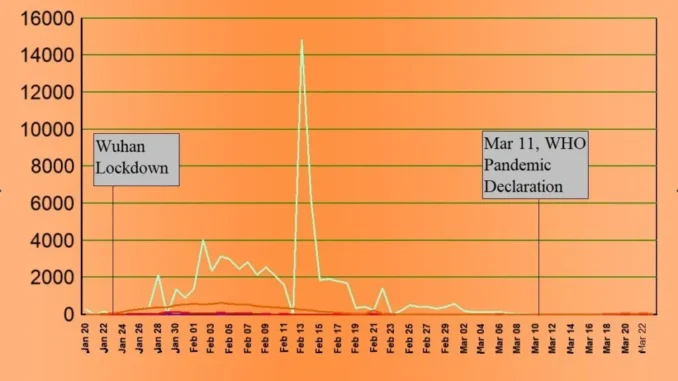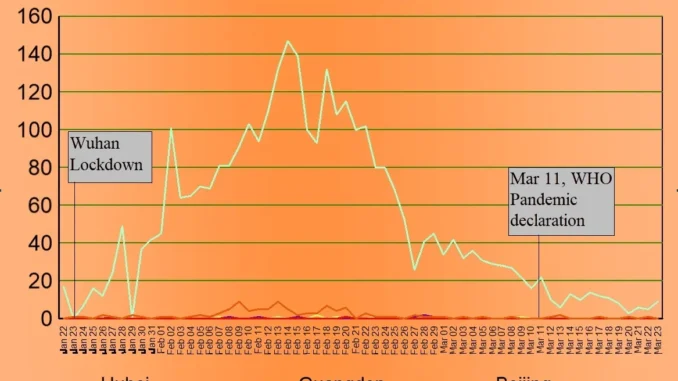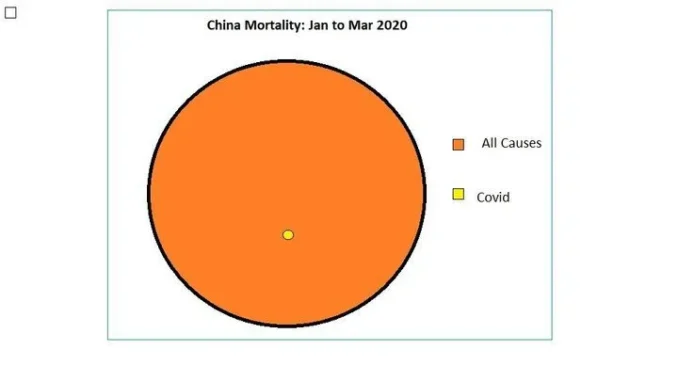E. Rowell: Think about these data when the WHO declares its next “pandemic.”
By Thomas Verduyn, PANDA UNCUT 28 February 2024

As a result, it has been taken for granted by most that the city of Wuhan was the starting point of the Covid pandemic. While there has been much debate about where the virus came from—that is, whether it jumped to humans from an animal source at the Wuhan wet market or whether it leaked from the Wuhan Institute of Virology—few have questioned that a pandemic started in Wuhan.
Science, however, is not about taking things for granted, but about questioning narratives and investigating facts. With this in mind, we wish to consider in more detail what happened in China in early 2020.
The city of Wuhan with its population of more than 11 million people is about 20% larger than New York City (NYC), the largest city in the US. It is the capital city of the Chinese province of Hubei, and is considered one of the nine most important cities in China. On 23 January 2020, this enormous city was “placed under lockdown due to the 2019 Novel Coronavirus outbreak.” Hubei and other provinces in China followed suit soon after, albeit with different levels of restrictions.
During the 24 days between 31 December 2019 (when something “unknown” was first picked up) and 23 January 2020 (when Wuhan was “locked down”), the total number of cases of Covid in the entire province of Hubei was 444. The number of deaths attributed to Covid during this same 24-day period was seventeen.[JHU CSSE COVID-19 Data] Although some people question the validity of Covid data emanating out of China, it is important to note that the WHO accepted the data as reliable, and their decisions were based on it.
It is helpful to put this number of deaths into perspective. The crude mortality rate of Hubei is about 5.9 per 1,000 residents, and the population of Hubei is 58 million. Thus, on average, 22,500 people in Hubei die during a normal 24-day period. The 17 Covid deaths, therefore, were effectively negligible. Locking down a province of 58 million people for just 17 deaths in 24 days is certainly an extreme response.
Was there something particularly lethal about Covid that warranted it? Based on the number of reported cases (444) and deaths (17), the case fatality rate (CFR) of Covid in Hubei province as of 23 January 2020 was 3.8%. For all of China it was 2.6% (17 deaths, 643 cases). Although this is higher than that for influenza A, it is four times less than the CFR of SARS, thirteen times less than that for MERS, and there are several dozen other human infectious diseases with a CFR greater than 2.6%. Also, and more importantly, the CFR for any “unknown” disease will almost certainly appear much higher than it actually is until more information becomes available. Indeed, only one week later (1 February 2020), the CFR had already dropped to 0.7%, and was showing signs of being on par with the flu.
Two days after the city of Wuhan was locked down, the Chinese New Year was ushered in (25 January 2020). This day is an important holiday in China. It usually involves many days of festivities and of increased travelling, making it “the world’s largest annual migration.” Since the surge in travel volumes usually begins two weeks before the New Year, it had been ongoing for some time before the lockdown was initiated. According to Fan et al., “Due to the impending Chinese New Year, more than five million people travelled from Wuhan for either family reunions and/or holidays, contributing to the subsequent outbreak of Covid-19 in every province/region in China within a matter of weeks.” The notion of locking down a province to stop the spread of a virus after five million people had already left the province, and would shortly return, makes this response even more odd.
How bad was the “outbreak” of Covid that was purported to have been caused by this mass migration? To answer this question, we plotted Covid cases in China by province from January to March 2020. As case numbers were so small in most provinces, we show only the four provinces with the highest numbers of cases. The remaining 29 provincial regions (Taiwan is excluded) are lumped together and treated as a single entity.
 Figure 1: Daily Covid Cases by Province in China, for the four provinces having the largest number of cases. Hubei province (light grey) dominates the graph. The other three provinces included in the graph (Guangdong, Beijing, and Zhejiang) are almost zero the entire time. “AllOtherProvinces” (brown line) is the daily sum of the remaining 29 provincial regions. Source: JHU CSSE COVID-19 Data. https://github.com/CSSEGISandData/COVID-19
Figure 1: Daily Covid Cases by Province in China, for the four provinces having the largest number of cases. Hubei province (light grey) dominates the graph. The other three provinces included in the graph (Guangdong, Beijing, and Zhejiang) are almost zero the entire time. “AllOtherProvinces” (brown line) is the daily sum of the remaining 29 provincial regions. Source: JHU CSSE COVID-19 Data. https://github.com/CSSEGISandData/COVID-19
Several aspects of the preceding graph are worth noting. In the first place, the number of cases in Wuhan dwarfed all other provinces combined. Total cases in Hubei by the end of March amounted to 67,800, whereas the combined total in the other 32 provincial areas was only 13,639. Therefore, despite the exodus of five million people out of Wuhan in the days leading up to the lockdown, despite there being cases in every other province, and despite the other provinces not being locked down as tightly as Hubei province was, somehow the SARS-CoV-2 virus didn’t seem to spread in those provinces. Nor can the difference be attributed to population density, as 14 of the 33 provincial regions are more densely populated than Hubei.
Second, the spike in cases that occurred in Hubei province on 13 February 2020 is somewhat misleading. The increase resulted because China changed its policy and began including not only lab-confirmed cases but clinically diagnosed cases as well. This policy change was in place for about two weeks and, in consequence, artificially inflated the number of cases by about ten thousand. Covid, after all, is clinically indistinct from other common respiratory viruses.
Third, the total number of cases in China in the first three months was 81,439. Given that China has a population of 1.5 billion, it is observed that during these three months less than 0.006% of the populace was infected. Such a low number of infections argues strongly against the common claim that Covid is a “highly contagious disease.” This is especially so given the fact that this almost negligible infection rate happened in the context of a mass migration and millions of family gatherings.
Fourth, the lockdown of Wuhan and the restrictions placed on the rest of China seem to have had no impact whatsoever on the trajectory of Covid cases. Cases began to rise after the lockdown was initiated, continued along a generally increasing trend for three weeks thereafter, and then tapered off to zero. By the time the WHO declared Covid a pandemic, it had entirely fizzled out in China.
Multiple published studies have claimed that the lockdown of Wuhan successfully eradicated Covid from the province. To justify the claim, the authors typically assume a three-week lag, thereby making the drop in cases artificially align with when the lockdown supposedly began to take effect. However, the papers we looked at have no more proven that the lockdown caused the decline than that the Chinese New Year caused it, for the timing of that event is also about three weeks before cases peaked. Furthermore, multiple studies into the usefulness of lockdowns in other countries concluded that lockdowns did not change the trajectory of Covid. Figure 1 above is a powerful visual demonstration of this.
Covid Deaths in China





Another far left bought and paid for western CCP apologist.
Laura
And there is also other very strong evidence the disease began to spread from the Wet Market in Wuhan. Not from the Lab.9
Check the geography. The Lab is not close and across the river.
@Laura
Whereas I wouldn’t disagree with this statement, it should be recognized to be true of all the major data sets which were collected on Covid. Also, in the West, this was not by mistake, but by complete intention to manipulate the data to make it appear worse and thereby frighten people all the more. Notably Birx has testified as to this fact. And this lack of trustworthiness was only exacerbated in the data which was later collected with regards to the shots. This was made certain by the absurd manner in which “vaccinated” people were routinely counted as being non-vaccinated when they became ill in the days following their “vaccination”. Beyond this, the decision by the US to allow the individual states to choose their own manner of data collection with regards to the shots, rendered that data to be largely useless. Then there was the intrigues surrounding the ‘data error’ which was claimed to have taken place in the US army data going back several years, which was ‘fixed’ to demonstrate that the highly concerning results which were evident in the data following the shots were actually completely “normal”.
Whereas these facts reveal an important characterization regarding the Western data which are altogether unrealatable to the Chinese data, I would easily not describe the Chinese data to be trustworthy. The Chinese have every reason to cleanse their data to support the Chinese narrative as needed, and as they control all access and every record of that data,they have the means to manipulate the data, along with those who are reviewing that data, as it suits their interests to do so.
As to the lab origin of the virus, Felix does dispute it, but I would agree with your conclusion that such disputes are not well based, even as the vaccine advocates continue to claim otherwise despite clear evidence to the contrary.
Laura
Statement from Prof Edward Holmes on the SARS-CoV-2 virus
16 April 2020
Unfounded speculation on the origins of the SARS-CoV-2 virus that causes COVID-19 has prompted the following statement from Professor Holmes, who was involved in mapping the genome of the virus.
COVID-19
Latest research news
Professor Edward Holmes.
Professor Edward Holmes.
“There is no evidence that SARS-CoV-2, the virus that causes COVID-19 in humans, originated in a laboratory in Wuhan, China.
“Coronaviruses like SARS-CoV-2 are commonly found in wildlife species and frequently jump to new hosts. This is also the most likely explanation for the origin of SARS-CoV-2.
“The closest known relative of SARS-CoV-2 is a bat virus named RaTG13, which was kept at the Wuhan Institute of Virology. There is some unfounded speculation that this virus was the origin of SARS-CoV-2. However:
(i) RaTG13 was sampled from a different province of China (Yunnan) to where COVID-19 first appeared; and
(ii) the level of genome sequence divergence between SARS-CoV-2 and RaTG13 is equivalent to an average of 50 years (and at least 20 years) of evolutionary change.
“Hence, SARS-CoV-2 was not derived from RaTG13.
“In addition, we know that viruses related to SARS-CoV-2 are also found in pangolins. This suggests that other wildlife species are likely to carry relatives of SARS-CoV-2.
“In summary, the abundance, diversity and evolution of coronaviruses in wildlife strongly suggests that this virus is of natural origin. However, a greater sampling of animal species in nature, including bats from Hubei province, is needed to resolve the exact origins of SARS-CoV-2.”
Professor Edward Holmes is an Australian Research Council Laureate Fellow, a Fellow of the Australian Academy of Science and a Fellow of the Royal Society in London.
He has published six academic papers this year on the genome and origin of SARS-CoV-2, the virus that causes COVID-19 in humans.
At the University of Sydney he is a member of the Charles Perkins Centre and the Marie Bashir Institute for Infectious Diseases and Biosecurity. He holds a joint position with the School of Life and Environmental Sciences and the Sydney Medical School.
Marcus Strom
Science Media Adviser
Email
marcus.strom@sydney.edu.au
Details
Due to the volume of work on SARS-CoV-2 research, Professor Holmes is not available for interview.
Related articles
News_
09 April 2020
Professor Edward Holmes.
COVID-19: Time is now to prepare for the next coronavirus outbreak
Professor Edward Holmes – who helped map the COVID-19 virus genome – issues a call to action to limit the impact of this coronavirus and prepare for any future outbreaks.
Laura
No! It came from.a bat Virus.
It likely originated in a farm one of very many farms of captivated wild animals all over China and Laos. There are many types of wild animals which could have been the original having jumped from a bat.
The science has covered all of this.
As regards the lab leak well disproved.
It is the way of Nature.
We can’t exactly believe the stats that come out of China. It’s a certainty that the china virus originated in the Wuhan lab. No one disputes that anymore.
Peloni it is easy for you to chatter on about “manufactured fear” but put yourself in the position of many patients struggling desperately for breath, who really feared a terrible death, and hospital staff of all ranks, who had to face danger unprepared due to cuts in a health service thanks especially to republicans.
“It was a pandemic of malfeasance perpetrated by psychopaths to manipulate publics around the world to sacrifice their liberties on the pyre of manufactured fear. To that extent I will concede that it was a pandemic, but nothing more.”
Seb
I thought you would know by now…Ted and Peloni do not link to scientific studies. They link to people like Peter McCullough who are in business (real business opportunity) (on the back of every person who spent their last hours gasping desperately for oxygen) of promotion of products of no merit.
That’s my point. To find out the TRUTH forget these nonsense merchants
Turn to real scientists.
Do not say I didn’t start you off.
Reading over the early days of this Pandemic it is TRULY remarkable how quickly Chinese scientists understood and also furnished world science with the TRUTH of this Pandemic caused by THIS virus.
@Felix
It was a pandemic of malfeasance perpetrated by psychopaths to manipulate publics around the world to sacrifice their liberties on the pyre of manufactured fear. To that extent I will concede that it was a pandemic, but nothing more.
@Sebastien
Under the charts and graphs, there is a link to
https://github.com/CSSEGISandData/COVID-19
This contains the archived data for China from four years ago.
In the first row in the box at the top of this page, it has a link titled “archived_data”. If you click on this link, it takes you to another page which includes links for both daily cases (with links per day) as well as for data collected over time (with links associated over periods of time), for China. I believe that this is the source of the data which is analyzed, graphed and discussed in the article.
If the link you followed took you to the John Hopkins site (black background, graphs on the right side, a map in the middle, and lists of cities or countries on the right side), which I think is what you were describing, I can only voice my shared frustration with that site. It literally took me weeks to master that site at the beginning of the Covid scamdemic, but I found it to be very difficult to navigate and not the slightest bit intuitive to use. The good news is that all the data from the ‘pandemic’ period has been archived for ready examination and data analysis.
Just FYI.
@Felix I meant in the article. We are in agreement here. I thought I was clear.
Peloni
Of course it was a pandemic.
Some historical facts here
“By metagenomic RNA sequencing and virus isolation from bronchoalveolar lavage fluid samples from patients with severe pneumonia, independent teams of Chinese scientists identified that the causative agent of this emerging disease is a betacoronavirus that had never been seen before6,10,11. On 9 January 2020, the result of this etiological identification was publicly announced (Fig. 1). The first genome sequence of the novel coronavirus was published on the Virological website on 10 January, and more nearly complete genome sequences determined by different research institutes were then released via the GISAID database on 12 January7. Later, more patients with no history of exposure to Huanan Seafood Wholesale Market were identified. Several familial clusters of infection were reported, and nosocomial infection also occurred in health-care facilities. All these cases”
https://www.nature.com/articles/s41579-020-00459-7
Sebastien
There’s mountains of studies. Here’s an example
“Tried to follow links. There’s no supporting data. Nothing about China, almost 18 million deaths worldwide.”
https://www.nature.com/articles/s41579-020-00459-7
Tried to follow links. There’s no supporting data. Nothing about China, almost 18 million deaths worldwide.
@Felix
Not exactly a novel statement at this point.
The Stalinist Bureaucracy has a responsibility… They did not put an end to the trade and marketing of wild animals. Responsibility of Trotskyism in uncovering the truth about Covid
Article posted by Ted Belman…All anti-scientific rubbish I am afraid.
Nothing makes any sense in the lethal virus denial pushed by Israpundit, (among others there Ted Belman and Peloni) claiming to speak for Jews, but it’s climate and virology denial is leading Jews to use a false science rejection OF THE TRUTH. This Israpundit article denies that it was a pandemic at all. That ultra stupid claim will set up lethal outcomes if not challenged.
This virus was always threading the same path as its predecessor…Severe acute respiratory syndrome coronavirus 1 (SARS-CoV-1), 2002 to 2004. The transition to humans of that virus was via the wild animal markets. The Stalinist bureaucracy had given an undertaking to put an end to the trade and did not.
As far as I a Trotskyist is concerned the clue to the origin of Sars Cob 2 always lay in the inability of the Stalinist bureaucracy to end the trade in wild animals. And it is to the Wuhan wet market that we must look. It is there. That is the origin. Not a “lab leak”… That’s a lie and a diversion.
It means that to understand the complex path of this virus one has to pay close attention to the role of the Stalinist Bureaucracy and only Trotskyism can do this.